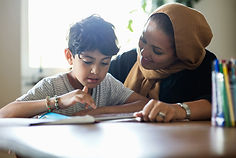About Literacy Development
The foundation for decoding new words is built upon two competencies: phonological awareness and phonics. Additionally, students must understand concepts of print, such as identifying the front cover, back cover, and, and that English goes from left to right. Frequent confirming and extending conversations build their listening comprehension, content knowledge, and critical thinking, which are essential for success with a of texts. Successful readers have both strong decoding skills to read new words and strong listening comprehension skills. Both are necessarily for skilled grade level reading.
Reading Aloud to Your Child
Children develop a love for books when they are read to by loved ones. Reading aloud to children is a crucial activity that helps build the knowledge necessary for reading success. It helps children learn new words, understand the world, and recognize the connection between spoken and written words.
Source: National Institute for Literacy's publication, "A Child Becomes a Reader: Proven Ideas from Research for Parents."
Choose
Choose a book your child is interested in. It should be more difficult than a book they can read independently.

Discuss
Ask questions that are about ideas or words from the book, can be answered with more than one or two words, and need information from the story to answer.

Vocabulary
Talk about new words that your child has read or heard. Ask them to make up sentences with the new words or use the words in other situations.

Listening to Your Child Read
Pause
Pause whenever your child errs, but also at the end of a sentence or success. You can wait to see if they fix the mistake and if not, step in with a cue to re-read the sounds.
Prompt
Allow your child to try! Cue them to say the sounds or break apart long words into smaller words.
Praise
Praise whatever your child correctly read; confirm: "Good! That says 'cat'."
Practice
Repetition is important; Read that same word or find a new word in that book that begins with "c" and practice that word.
Other Shared Reading Techniques
Choral Reading
Reading as a "chorus" together; adult is slightly louder than child as the adult models fluent reading

Varied Volume
Similar to choral reading, but the adults gets quieter as the child gets louder

Echo Reading
Adult reads a sentence while pointing to each word; child reads the same sentence while pointing to each word


